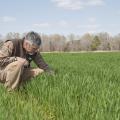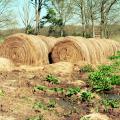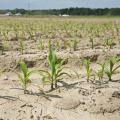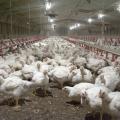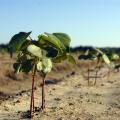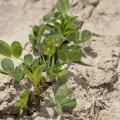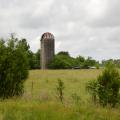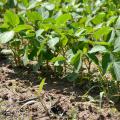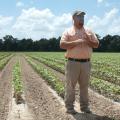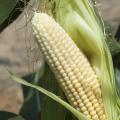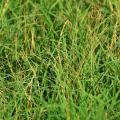Crop Report from 2014
MISSISSIPPI STATE -- This year’s cold winter slowed wheat growth so the late-March freeze across much of Mississippi probably did not cause major damage to the state’s wheat crop.
Erick Larson, grain crops agronomist with the Mississippi State University Extension Service, said most wheat across the state had not reached a growth stage where it would have been sensitive to freezing temperatures when the cold returned on March 26.
MISSISSIPPI STATE – Memories of last year’s bumper crops have Mississippi farmers eager for fields to dry out so they can plant the 2014 crop.
Market potential remains the first consideration when making crop choices.
“Prices are driving growers’ planting decisions,” said Brian Williams, an agricultural economist with the Mississippi State University Extension Service. “Mississippi corn is trading about $2.50 per bushel lower than a year ago, while Mississippi soybean prices are slightly higher than a year ago.”
MISSISSIPPI STATE -- Markets for Mississippi’s sawtimber and pulpwood are bouncing back from the economic recession, but the industry is not improving across the board.
“Slowly but surely, markets for sawtimber are beginning to grow again after the sharp declines seen after the collapse of the U.S. housing market and the ensuing recession,” said James Henderson, associate Extension professor of forestry at Mississippi State University. “But the closing of the International Paper mill in Courtland, Ala. will have an impact on north Mississippi’s pulpwood markets.”
JACKSON – Hay producers need warmer temperatures and drier ground to catch up with production this spring.
“Everything is shaping up to be late with all the wet, cool weather we’ve had,” said Charlie Bush, Mississippi State University Extension Service agent in Simpson County. Simpson was one of the counties where some fields flooded after most areas in central Mississippi received between three and 10 inches of rain between April 5 and 7.
MISSISSIPPI STATE -- Spring rains are delaying the state’s corn planting much as they did in 2013, but growers will not complain if the season ends with another record harvest like last year’s.
The U.S. Department of Agriculture estimated the crop was just 64 percent planted by April 20, putting it farther behind than it was at this time last year and well behind the five-year average of 87 percent planted. It takes five to 10 days after a rain before growers are able to resume planting in saturated soils, and frequent rains have kept most growers from planting as intended.
MISSISSIPPI STATE – Unseasonably cool temperatures in the wake of historic tornado activity could be a boon for the state’s strawberry growers.
“The weather over the past few days has been tough, but it’s still early in the strawberry season,” said Brooks Brownlee of Brownlee Farms in Red Banks, Mississippi. “This year has been the latest start we’ve ever had -- we just started picking on April 24. But the cool weather that delayed the crop may be a good thing and prolong our season.”
MISSISSIPPI STATE – The poultry industry is riding a wave of success, propelling it from a strong 2013 into another year with promises of favorable market prices and lower production costs.
John Michael Riley, an agricultural economist with the Mississippi State University Extension Service, said several issues will influence poultry profits in 2014.
MISSISSIPPI STATE – Frequent rains kept farmers indoors through much of April, but clear weather in early May allowed them to play catch-up on row-crop planting.
The U.S. Department of Agriculture reported that planting of most of the state’s row crops is back on schedule after the wet early spring. Corn is the first crop planted in Mississippi and much of it was planted on schedule. As of May 11, USDA reported cotton is 45 percent planted, rice is 68 percent planted, grain sorghum is 42 percent planted and soybean is 55 percent planted.
JACKSON -- Most peanut growers are on schedule despite the cool, wet weather that hit Mississippi at the beginning of May.
“We are in pretty good shape all over the state,” said Jason Sarver, peanut specialist with the Mississippi State University Extension Service and Mississippi Agricultural and Forestry Experiment Station. “The cool, wet spell we had set some folks back, but only by a week or so. Depending on this summer’s conditions, their harvest might be pushed a little later, but nothing extreme.”
TYLERTOWN -- Mississippians looking to raise a glass to celebrate “June is Dairy Month” with local producers may be drinking their milk alone.
Walthall County Extension agent Richard Hay has seen a drastic change in dairy numbers in his county since he arrived in 1984.
“We had more than 200 dairy farms when I started my Extension career in Walthall County. Today, the number is closer to 14,” he said. “The good news is if you are still in the business, you are one tough dairy farmer.”
STONEVILLE -- With Mississippi’s rice crop about two weeks later than normal, growers will have narrow windows of opportunity to perform necessary management as it grows.
The U.S. Department of Agriculture estimated 92 percent of rice was planted by June 1. Seventy-four percent of the crop that has emerged was in good to excellent condition.
Bobby Golden, Mississippi Agricultural and Forestry Experiment Station agronomist in Stoneville, said the late planting and heavy rains in late May are making management a challenge.
JACKSON -- Although most of the state’s soybeans have been planted, Mississippi famers will have to deal with the consequences of this spring’s wet weather for the rest of the growing season.
“We never want to wish away a rain in June,” said Trent Irby, Mississippi State University Extension Service soybean specialist. “But growers are and will continue to experience some issues because of the excess rain we’ve had.”
Irby estimates the state’s largest row crop is 90 percent planted, and some fields are already in the reproductive stage.
MISSISSIPPI STATE -- Mississippi cotton producers remain optimistic about a crop that is up significantly in acreage despite frequent planting delays.
The state is expected to plant about 400,000 acres of cotton in 2014, about 40 percent more than last year. The U.S. Department of Agriculture reported on June 15 that cotton was 98 percent planted. USDA rated 65 percent of the crop as “good” or “excellent,” but 32 percent was rated “fair.”
JACKSON – Party planners may have a hard time finding Mississippi-grown watermelons and blueberries for July 4th celebrations this year.
Unfavorable weather slowed maturity and increased disease pressure for both crops. Much of the state’s blueberry crop is grown in south Mississippi, and most of its watermelons are grown in the southeast quarter of the state. Acreage for both crops remains steady. Blueberry producers grow about 2,700 acres, and watermelon growers have about 2,400 acres.
BILOXI -- Mississippi shrimpers had an excellent opening day, a fact that had them pleasantly surprised.
Based on reports from just two of Biloxi’s three shrimp dealers as of July 1, fishermen landed 790,000 pounds of shrimp in the first week. Last year, all three Biloxi shrimp dealers reported total first-week landings of 541,000 pounds of shrimp.
Dave Burrage, professor of marine resources with the Mississippi State University Extension Service, said hot, dry spring weather is considered good for shrimp crops, but the state got the exact opposite this year.
MISSISSIPPI STATE -- Cattle and hog prices are soaring to record highs, causing producers to debate whether to sell their valuable animals or expand their herd sizes for the future.
“It’s hard not to sell when prices are this good and the pull of the feedlot is so strong,” said John Michael Riley, an agricultural economist with the Mississippi State University Extension Service.
As producers continue to reduce herd sizes nationally, prices should remain strong, but the result will be fewer animals available to sell in the future.
MISSISSIPPI STATE -- Who knew Mississippi corn growers should worry about bears?
The bears are not in the fields eating the crop; they are in the market, eating the profits. When economists refer to a bear market, they are talking about declining stock prices over a prolonged period, usually a 20 percent or larger decline.
Brian Williams, agricultural economist with the Mississippi State University Extension Service, said several factors have pushed corn prices down in recent weeks.
JACKSON -- Turf and forage producers in Mississippi need fewer clouds and more sunshine.
In 2014, forage producers raised an estimated 600,000 acres of hay across the state. There are about 60 farms producing sod for sale in the state.
Turf production…
The unusually harsh winter melted into a cool, wet spring and summer, which slowed spring growth and intensified diseases and last fall’s herbicide injury in sod, said Jay McCurdy, turf grass specialist with the Mississippi State University Extension Service.
STONEVILLE -- There is a reason catfish do well in Mississippi: hot summers.
“An unusually cool summer like we have had can create nice days for people, but the temperatures have caused some problems for our catfish,” said Jimmy Avery, Extension aquaculture specialist at the Mississippi State University Delta Research and Extension Center.
JACKSON -- Locally grown produce continues to increase in popularity on Mississippi’s kitchen counters, grocery shelves and restaurant menus as consumers seek fresher fruits and vegetables.
To get them, they often turn to the state’s truck crops growers, who traditionally sold their specialty items, such as tomatoes, berries, nuts and sweet corn, from the beds of their pickup trucks.

